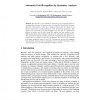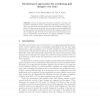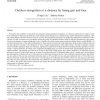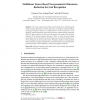733 search results - page 3 / 147 » Biometric Gait Recognition |
AVBPA
2001
Springer
14 years 7 days ago
2001
Springer
We describe a new method for automatic gait recognition based on analysing the symmetry of human motion, by using the Generalised Symmetry Operator. This operator, rather than rely...
IWBRS
2005
Springer
14 years 1 months ago
2005
Springer
Interest in automated biometrics continues to increase, but has little consideration of time. This paper deals with a problem of recognition by gait when time-dependent and time-in...
BMVC
2001
13 years 10 months ago
2001
Gait is a new biometric aimed to recognise a subject by the manner in which they walk. Gait has several advantages over other biometrics, most notably that it is non-invasive and ...
IVC
2007
13 years 7 months ago
2007
We explore the possibility of using both face and gait in enhancing human recognition at a distance performance in outdoor conditions. Although the individual performance of gait ...
ICB
2009
Springer
14 years 2 months ago
2009
Springer
The small sample size problem and the difficulty in determining the optimal reduced dimension limit the application of subspace learning methods in the gait recognition domain. To...




